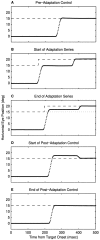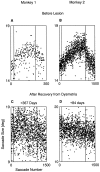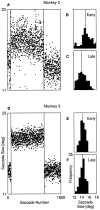Saccadic dysmetria and adaptation after lesions of the cerebellar cortex
- PMID: 10594074
- PMCID: PMC6784948
- DOI: 10.1523/JNEUROSCI.19-24-10931.1999
Saccadic dysmetria and adaptation after lesions of the cerebellar cortex
Abstract
We studied the effects of small lesions of the oculomotor vermis of the cerebellar cortex on the ability of monkeys to execute and adapt saccadic eye movements. For saccades in one horizontal direction, the lesions led to an initial gross hypometria and a permanent abolition of the capacity for rapid adaptation. Mean saccade amplitude recovered from the initial hypometria, although variability remained high. A series of hundreds of repetitive saccades in the same direction resulted in gradual decrement of amplitude. Saccades in other directions were less strongly affected by the lesions. We suggest the following. (1) The cerebellar cortex is constantly recalibrating the saccadic system, thus compensating for rapid biomechanical changes such as might be caused by muscle fatigue. (2) A mechanism capable of slow recovery from dysmetria is revealed despite the permanent absence of rapid adaptation.
Figures







References
-
- Albano JE, King WM. Rapid adaptation of saccadic amplitude in humans and monkeys. Invest Ophthalmol Vis Sci. 1989;30:1883–1893. - PubMed
-
- Aschoff JC, Cohen B. Changes in saccadic eye movements produced by cerebellar cortical lesions. Exp Neurol. 1971;32:123–133. - PubMed
-
- Barash S, Melikyan A, Sivakov A, Tauber M. Shift of visual fixation dependent on background illumination. J Neurophysiol. 1998;79:2766–2781. - PubMed
-
- Botzel K, Rottach K, Buettner U. Normal and pathological saccadic dysmetria. Brain. 1993;116:337–353. - PubMed
-
- Buettner U, Fuhry L. Eye movements. Curr Opin Neurol. 1995;8:77–82. - PubMed
Publication types
MeSH terms
LinkOut - more resources
Full Text Sources
Medical
